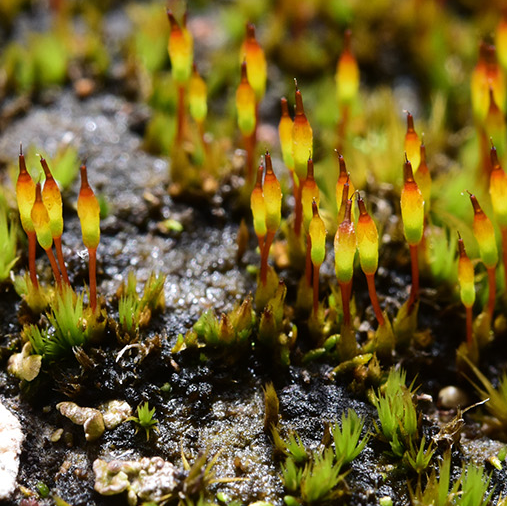 Zhang L., Q. Zuo, W.Z. Ma, J. Shevock, N. Patel, M. Johnson, R. Medina, N. Wilding & B. Goffinet. 2023 Phylogenomics resolves the rediscovered Himalayan endemic Brachymeniopsis gymnostoma (Bryophyta, Funariaceae), as a species of Entosthodon, prompting also the transfer of Clavitheca poeltii. Taxon 72: 1216–1227. pdf
Zhang L., Q. Zuo, W.Z. Ma, J. Shevock, N. Patel, M. Johnson, R. Medina, N. Wilding & B. Goffinet. 2023 Phylogenomics resolves the rediscovered Himalayan endemic Brachymeniopsis gymnostoma (Bryophyta, Funariaceae), as a species of Entosthodon, prompting also the transfer of Clavitheca poeltii. Taxon 72: 1216–1227. pdf
Abstract reads: Traits of the spore-bearing generation have historically provided the basis for systematic concepts across the phylogenetic spectrum and depth of mosses. Whether taxa characterized by a simple sporophytic architecture are closely related or emerged from independent reduction is often ambiguous. Phylogenomic inferences in the Funariaceae, which hold the model taxon Physcomitrium patens, revealed that several such shifts in sporophyte complexity occurred, and mostly within the Entosthodon-Physcomitrium complex. Here, we report the rediscovery of the monospecific, Himalayan endemic genera Brachymeniopsis and Clavitheca, after nearly 100 years and 40 years since their respective descriptions. The genera are characterized by, among other traits, their short sporophytes lacking the sporangial peristome teeth controlling spore dispersal. Phylogenomic inferences reveal that Brachymeniopsis gymnostoma arose within the clade of Entosthodon s.str., a genus with typically long-exserted capsules. We therefore propose to transfer B. gymnostoma to the genus Entosthodon, as E. gymnostomus comb. nov. Furthermore, Clavitheca poeltii, the sole species of the genus, is morphologically highly similar to E. gymnostomus, and should also be transferred to Entosthodon, but is retained as a distinct taxon, E. poeltii comb. nov., until additional populations allow for testing the robustness of the observed divergence in costa and seta length between the Nepalese and Chinese populations.
 Zhang L., Q. Zuo, W.Z. Ma, J. Shevock, N. Patel, M. Johnson, R. Medina, N. Wilding & B. Goffinet. 2023 Phylogenomics resolves the rediscovered Himalayan endemic Brachymeniopsis gymnostoma (Bryophyta, Funariaceae), as a species of Entosthodon, prompting also the transfer of Clavitheca poeltii. Taxon 72: 1216–1227. pdf
Zhang L., Q. Zuo, W.Z. Ma, J. Shevock, N. Patel, M. Johnson, R. Medina, N. Wilding & B. Goffinet. 2023 Phylogenomics resolves the rediscovered Himalayan endemic Brachymeniopsis gymnostoma (Bryophyta, Funariaceae), as a species of Entosthodon, prompting also the transfer of Clavitheca poeltii. Taxon 72: 1216–1227. pdf Zhang L., Q. Zuo, W.Z. Ma, J. Shevock, N. Patel, M. Johnson, R. Medina, N. Wilding & B. Goffinet. 2023 Phylogenomics resolves the rediscovered Himalayan endemic Brachymeniopsis gymnostoma (Bryophyta, Funariaceae), as a species of Entosthodon, prompting also the transfer of Clavitheca poeltii. Taxon 72: 1216–1227. pdf
Zhang L., Q. Zuo, W.Z. Ma, J. Shevock, N. Patel, M. Johnson, R. Medina, N. Wilding & B. Goffinet. 2023 Phylogenomics resolves the rediscovered Himalayan endemic Brachymeniopsis gymnostoma (Bryophyta, Funariaceae), as a species of Entosthodon, prompting also the transfer of Clavitheca poeltii. Taxon 72: 1216–1227. pdf